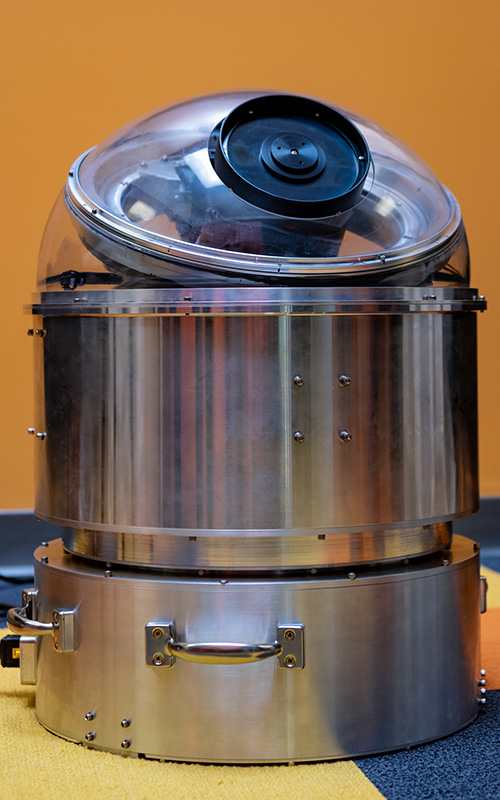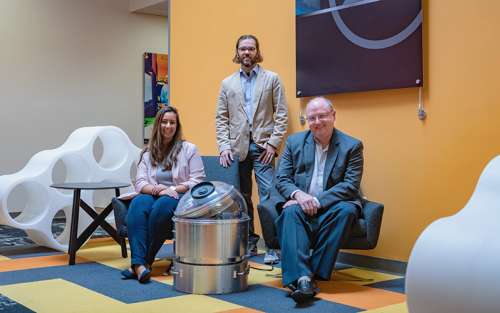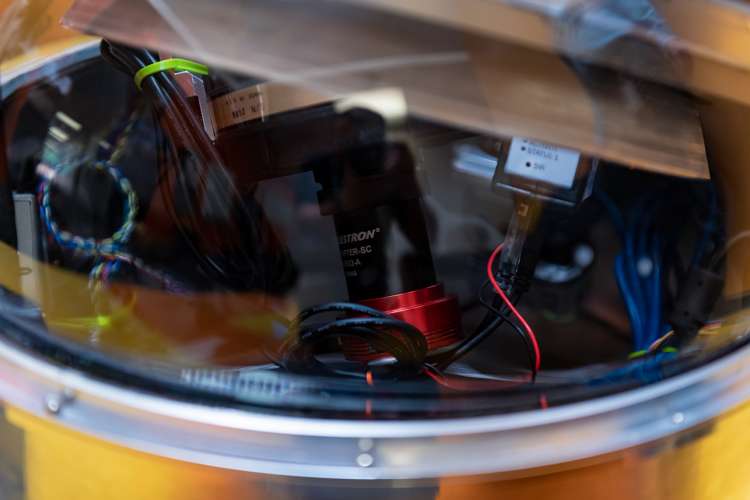Telescopes have long been one of our most powerful tools for observing satellites, stars and other celestial objects passing overhead.
But they’re also among our most sensitive.
“They’re fragile and finicky. You have to open domes up to allow the optics to look out, which allows contaminants to get in…You have to have a facility with power and ethernet, and at least one human there to run it all the time. That’s very expensive,” said Matthew Britton, Director of the Integrated Sensor Design and Analysis Department at The Aerospace Corporation. “It’s always been a problem to manufacture multiple units. Each one is kind of a one-off item.”

With the potential for tens of thousands of new satellites to be launched in the coming years as low-earth orbit constellations take shape and new launch vehicles make space more accessible, ground systems will have to evolve to keep pace with increased demands for tracking and communication capabilities.
Enter Monocle.
The trash can-sized device designed by Britton and a team of Aerospace engineers presents a new way of thinking about telescopes, offering a glimpse of a possible future where mass-production and resilient design transform how we monitor the skies above.
Monocle Leverages IoT Technology
The patented prototype utilizes a unique pointing and tracking system that allows the telescope’s optics to be fully-enclosed within a dome. This protects the optics from outdoor elements like wind or rain and provides thermal stability, enabling the device to be remotely-operated in a variety of environments.
The dome design also allows for a light-filtering baffle to be attached to the telescope, allowing it to capture images even during daytime hours, something traditional telescopes are not capable of.
Throw in wireless connectivity and a 120v power cord that can be plugged into a standard wall socket, and the Monocle begins to take on characteristics of the new breed of Internet-of-Things connected devices.
“It’s basically an appliance,” Britton said. “As long as there’s an internet connection, your refrigerator can order food or your doors can unlock at the command of a phone. This particular device can point and track based on a request over the internet, with the data shipped wirelessly out of the dome and back onto the internet where it can be disseminated.”
Monocle Could Play a Critical Role in the Future of Space
While the Monocle’s function is limited as an individual device, its true potential lies in creating a network of mass-produced sensors based on Monocle’s design. Through a heavy reliance on commercial off-the-shelf parts, producing the Monocle costs in range of tens of thousands of dollars, a fraction of the cost of legacy systems that run into the millions or tens of millions of dollars.
“It’s intentionally designed to be scalable,” said Randy Villahermosa, General Manager of iLab. “If it does what we think it will do, every copy after the first we can stamp out at a modular cost increase.”
Development of Monocle is being funded through iLab’s Ventures program, as part of a portfolio of projects aimed at exploring how proliferation will shape space systems.
Ground systems and sensors are a particularly ripe area for disruption as space gets more congested and new threats to on-orbit satellites emerge, Villahermosa said.

“The broader problem is ‘How do we get better situational awareness and be able to orient and observe what’s happening?” he said. “This is taking big systems and making them into smaller systems. It’s also an opportunity for Aerospace to explore how to utilize ground systems and ground sensors when we think about potential threats in space.”
For now, Monocle exists as a singular device, with Britton and team continuing to make refinements in preparation for a first-light demonstration in early 2020.
The potential uses for the device and its underlying technology are many – from imaging objects in the sky to using a laser to communicate with them – and it remains uncertain what path its development will ultimately take.
“Monocle is kind of a blank canvas,” Britton said. “You can paint on it what you want.”
This technology is available for license.
Technology Transfer at Aerospace
Aerospace has a variety of technologies available for licensing. For commercial companies, Aerospace may offer royalty-bearing exclusive or nonexclusive licenses, options, and low-fee evaluation licenses. For not-for-profits, FFRDCs, universities, and government agencies, Aerospace may offer royalty-free licenses.
Our office can assist you with executing a Non-Disclosure Agreement (NDA), software releases and end-user licenses, as well as patent know-how and copyright licensing.
Contact us at ip@aero.org.

